Project 49: Col. Fred Mears, WWI-era railroad engineer, and his wife Jane Mears, tremendous good sport
by Jamie Gonzales |
Project 49 is a monthly series from the University of Alaska Anchorage, highlighting characters and events from Alaska's rich history that have been preserved in our archives. Researched and written by Jamie Gonzales.
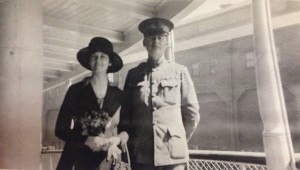
Frederick and Jane Mears in 1919. Frederick Mears collection, Archives & Special Collections, UAA/APU Consortium Library.
My mom cried when she first laid eyes on what was to be her Alaska home-a government trailer surrounded by a sea of rain-soaked gravel off of a back road in Kodiak, Alaska. She was fresh off a rough ferry ride between Washington and Alaska and I believe the first question she asked my dad was, "Is this a joke?" It was not. It was 1984 and she had left behind everything that was familiar to join my dad on what they knew would be an adventure for their young family. She just never thought it would be so very gray.
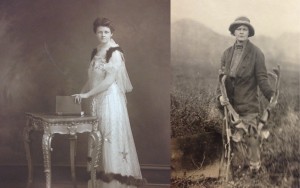
Jane Wainwright Mears, pictured at left before she arrived in Alaska and, at right, after she'd assimilated to frontier living. Frederick Mears collection, Archives & Special Collections, UAA/APU Consortium Library.
While my folks arrived well after Alaska's pioneer days, my mom comes closer than I ever will to understanding what Mrs. Jane Wainwright Mears, the wife of engineer Frederick Mears, must have felt stepping off the steamship in Alaska in 1914. Just 100 years ago, Alaska was still a wild place that was best accessed by boat, by horse or by dog team. It would be another 25 years until work began on a road to connect Alaska with Canada and the Lower 48-the venerated ALCAN. There were also less than 75 miles of train tracks in the state, a situation that Fred Mears was sent to help remedy.
Turning "Tent Town" into "Anchorage"
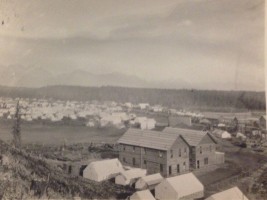
"Tent Town" by Ship Creek, later dubbed "Anchorage" by Frederick Mears. Frederick Mears collection, Archives & Special Collections, UAA/APU Consortium Library.
The Mears family made their home in Government Hill, overlooking Ship Creek's "Tent Town," a community Mears would later name "Anchorage." The images of Tent Town in the Frederick Mears collection (Consortium Library Archives & Special Collections) are enough to make most humans tear up. But men in search of work were flocking North to help build Alaska and the mud and canvas "city" wasn't enough to turn them away. One photograph in the Mears collection has a handwritten note on the back that gives a brief account of Mrs. Mears's steamship journey up to Alaska with her family and two members of her household staff, one of whom apparently took one look at Anchorage and hopped on the next steamship heading South.
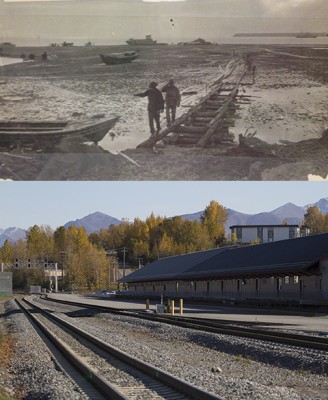
Ship Creek area then and now. In a phenomenal feat of engineering, the Alaska Railroad Commission punched through miles of rough terrain to connect Alaska's hub cities. Top image: Frederick Mears collection, Archives & Special Collections, UAA/APU Consortium Library. Bottom image by Philip Hall/University of Alaska Anchorage.
Following the federal purchase of Alaska's fledgling railways, President Roosevelt appointed Mears to the Alaska Engineering Commission. They were tasked with scouting the nearly 500-mile rail route that would connect Seward with Fairbanks. Mears's credentials were impressive-before moving his family to Alaska, he served as chief engineer and superintendent of the Panama Railroad and Steam Ship Company, routing and rerouting tracks alongside the newly constructed Panama Canal and commanding six ocean liners traveling between New York City and Panama.
Midway through his quest to connect Seward and Fairbanks, Mears was commissioned by the U.S. Army to help build railways in Europe. He left Alaska in 1918 to serve as colonel of the 31st Railroad Engineers in France, helping to create the infrastructure needed to route supplies and soldiers around the besieged country. When he returned to Anchorage, in 1919, he was named chief engineer of the Alaska Engineering Commission where he served until his retirement in 1923, the year the Alaska Railroad was completed.
Keeping love alive with semi-annual poetry
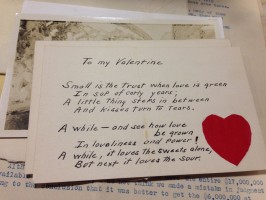
A Valentine from Fred Mears to his wife, Jane. Frederick Mears collection, Archives & Special Collections, UAA/APU Consortium Library.
I can't help it, when I'm leafing through these impressive historical documents, I'm most drawn to the love notes. Included alongside photographs portraying the building of the Alaska railroad and home life in frontier Alaska, are folders of news clippings notated by Mears's biographer, Katherine Crittenden, as well as official correspondence and some family letters.
On the outside of an aged vellum Department of the Interior envelope addressed "For Johnnie, Wishing you a Merry Christmas and a Happy New Year," the Mears's daughter scrawled, "Daddy wrote a poem to Mother every Christmas." (Johnnie was one of Jane's nicknames.) The handwritten poems seem to have been a Valentine's Day tradition, too.
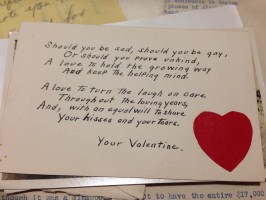
The last stanzas of Fred Mears's Valentine poem to his wife, Jane. Frederick Mears collection, Archives & Special Collections, UAA/APU Consortium Library.
Amid hand-cut red paper hearts on cardstock on one note, Col. Fred Mears, builder of Alaska's railroads, promises his Johnnie to share her laughter and her tears. Picturing Mears laboring over red tissue paper and scissors and notebooks of poem drafts to paste together his semi-annual tribute to his wife, it's almost enough to make up for the mud.
As far as I know, my mom, who grew to love Alaska, is still waiting for her handwritten holiday poems.
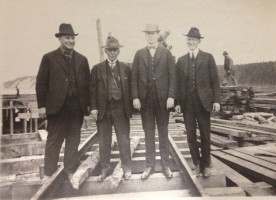
Frederick Mears, railroad engineer and part-time poet, stands second from right on a newly constructed Anchorage dock. Frederick Mears collection, Archives & Special Collections, UAA/APU Consortium Library.
The Anchorage Women's Club has published one of Fred Mears's less poetic exchanges with his wife. From the AWC website:
It is said that when Jane Mears approached her husband, Lt. Col. Fredrick Mears of the Alaska Engineering Commission, and asked him to build a school, his reply was, "I'm busy building a railroad; if you want a school you'll have to build it yourself."
And that's just what she did! On September 16, 1915, she and other women of the town organized The Anchorage Woman's Club, now a part of the General Federation of Women's Clubs established in 1890. Their primary goal in forming the club was to build a school. With left over material from the railroad, the women spearheaded the project and organized the construction of the first schoolhouse in Anchorage.
What remained of that schoolhouse was moved following the 1964 earthquake and is now the Pioneer Schoolhouse. Another Anchorage School District school, Jane Mears Middle School, was named in honor of Jane's work to establish formal education in Anchorage.The Frederick Mears collection is part of the Consortium Library Archives & Special Collections and its contents are open to the public. Please visit the Archives & Special Collections Facebook page or website to help plan your visit.
 "Project 49: Col. Fred Mears, WWI-era railroad engineer, and his wife Jane Mears, tremendous
good sport" is licensed under a Creative Commons Attribution-NonCommercial 4.0 International License.
"Project 49: Col. Fred Mears, WWI-era railroad engineer, and his wife Jane Mears, tremendous
good sport" is licensed under a Creative Commons Attribution-NonCommercial 4.0 International License.














